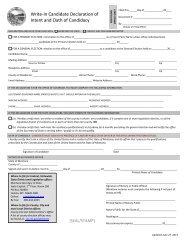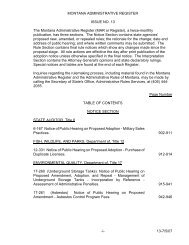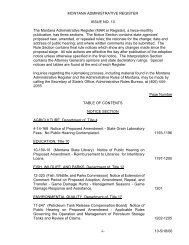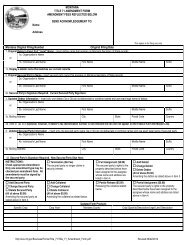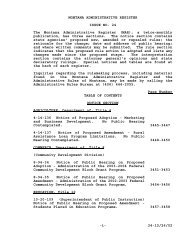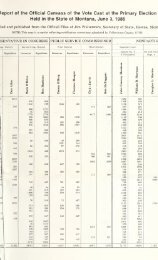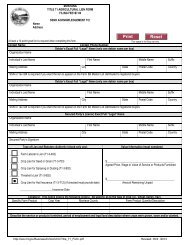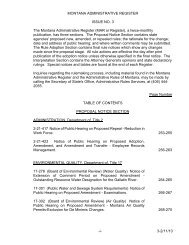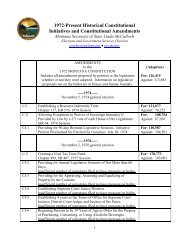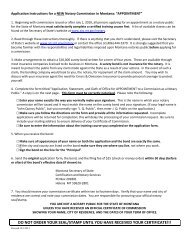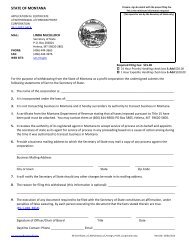Notary Handbook - the Montana Secretary of State Website
Notary Handbook - the Montana Secretary of State Website
Notary Handbook - the Montana Secretary of State Website
Create successful ePaper yourself
Turn your PDF publications into a flip-book with our unique Google optimized e-Paper software.
Administering Oaths - Although notaries are fully authorized to administer oaths, most <strong>of</strong> <strong>the</strong> time <strong>the</strong>y are done<br />
in conjunction with a signature – a jurat. There is no standardized verbiage mandated for various situations<br />
requiring an oath. In most cases <strong>the</strong> accompanying document will include <strong>the</strong> proper language for <strong>the</strong> specific oath<br />
that is to be administered.<br />
Suggested oath to be administered when performing a jurat notarization: “Do you swear that <strong>the</strong> information<br />
contained in this document is true and complete to <strong>the</strong> best <strong>of</strong> your knowledge and ability?”<br />
Witnessing or attesting a signature - Witnessing or attesting a signature is probably <strong>the</strong> most common <strong>of</strong> notarial<br />
acts requiring <strong>the</strong> notary to witness <strong>the</strong> signature by <strong>the</strong> signer who appears in person before <strong>the</strong> notary to do <strong>the</strong><br />
signing. The notary also must au<strong>the</strong>nticate <strong>the</strong> identity <strong>of</strong> <strong>the</strong> signer by approved methods. See pages 36 - 37 for<br />
examples <strong>of</strong> correct formats for this type <strong>of</strong> notarial block.<br />
Certifying copies - A <strong>Montana</strong> <strong>Notary</strong> Public may be asked to certify or attest that a copy <strong>of</strong> a document or o<strong>the</strong>r<br />
item is a full, true, and accurate transcription or reproduction <strong>of</strong> that which was copied. There are two ways to<br />
fulfill a request for a certified copy <strong>of</strong> a document:<br />
CERTIFICATION OF COPY - When someone brings an original document or when <strong>the</strong> original document is<br />
kept in <strong>the</strong> <strong>of</strong>fice where <strong>the</strong> notary works, <strong>the</strong> notary personally makes a copy <strong>of</strong> <strong>the</strong> document and <strong>the</strong>n<br />
affixes a notarial block as shown on page 41. The customer does not sign <strong>the</strong> document at all – only <strong>the</strong><br />
notary’s signature appears on <strong>the</strong> document. The notary must complete a journal entry for this type <strong>of</strong><br />
notarization, however <strong>the</strong> requester’s signature, printed name, and address is not required, but it is<br />
certainly acceptable to include it.<br />
NOTE: <strong>Montana</strong> notaries are prohibited from making and certifying copies <strong>of</strong> public documents, such as<br />
birth certificates, death certificates, marriage licenses, school transcripts, FBI fingerprint cards, and o<strong>the</strong>r<br />
<strong>of</strong>ficial records that are issued by state or o<strong>the</strong>r government <strong>of</strong>ficials. Generally any document that must<br />
be certified by <strong>the</strong> issuing agency, such as a clerk & recorder, a clerk <strong>of</strong> court, or <strong>the</strong> department <strong>of</strong> vital<br />
records cannot be copied and certified by a notary public. O<strong>the</strong>r government-issued documents, such as<br />
drivers’ licenses, diplomas, passports, or pr<strong>of</strong>essional licenses may be copied by <strong>the</strong> notary and certified as<br />
being true and accurate copies. If you are unsure whe<strong>the</strong>r you can certify a copy <strong>of</strong> a particular record or<br />
document, contact <strong>the</strong> <strong>Secretary</strong> <strong>of</strong> <strong>State</strong>’s <strong>of</strong>fice.<br />
CERTIFICATION BY DOCUMENT CUSTODIAN – A person may bring you a copy <strong>of</strong> a document and request<br />
that it be certified. In this situation, <strong>the</strong> notary should require <strong>the</strong> customer to certify that <strong>the</strong> copy is a<br />
true and accurate copy and sign <strong>the</strong> statement <strong>of</strong> certification. The notary <strong>the</strong>n places <strong>the</strong> customer under<br />
oath and performs a jurat notarization <strong>of</strong> <strong>the</strong> customer’s signature. In this situation, it is <strong>the</strong> customer who<br />
is attesting, under oath, to <strong>the</strong> au<strong>the</strong>nticity <strong>of</strong> <strong>the</strong> document, not <strong>the</strong> notary. “Certification by a document<br />
custodian” should not be used to certify copies <strong>of</strong> public records that cannot be certified by a notary<br />
public. The notary’s journal entry for this type <strong>of</strong> notarization would reflect that a jurat notarization was<br />
performed on a certification by document custodian as <strong>the</strong> type <strong>of</strong> notarial act. See <strong>the</strong> example on page<br />
41.<br />
Taking (transcribing) depositions and Making protests <strong>of</strong> instruments – These two types <strong>of</strong> notarial acts require<br />
additional training and cannot be performed by a notary unless <strong>the</strong>y are also court reporters or have been<br />
specifically trained by a financial institution to do protests. We will not discuss those notarial acts in any fur<strong>the</strong>r<br />
detail in this handbook.<br />
14



